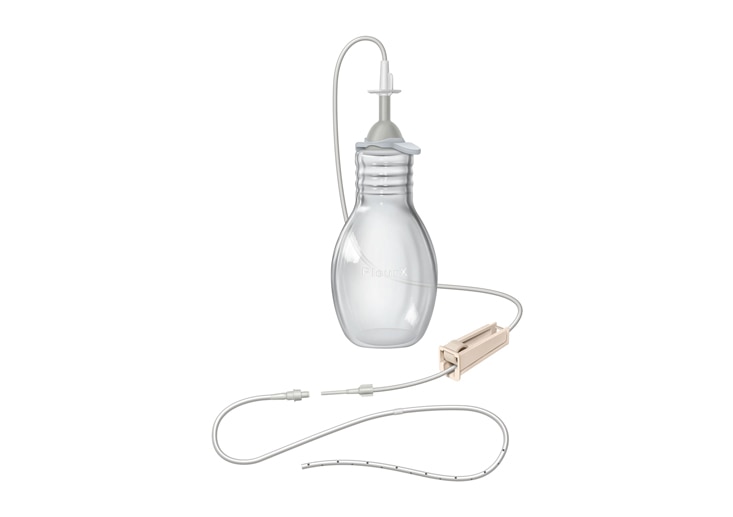Request a demo or get in touch with our sales representative
Sales Form
Please fill out the form and a sales representive will get in touch with you.
Equip your patients to manage recurrent pleural effusions, at home


The device is indicated for the palliation of dyspnea due to pleural effusion and providing pleurodesis (resolution of the pleural effusion).
Learn how to drain fluid using the PleurX system in the comfort of your own home.


Scan the code to download the app. Available in the Google Play Store and the Apple App Store.

The Patient Navigators offer compassionate guidance and assistance with obtaining drainage kits
Call us today at 833.549.7677
BD-34476 PleurX Pleural Catheter
PleurX Drainage Procedure
50-7245 PleurX Lockable Drainage Line Set
50-9000B / 50-9900 PleurX™ Peritoneal Catheter Kit
50-7000B / 50-7700 PleurX™Pleural Catheter Kit
50-7290 PleurX™Procedure Pack
The PleurX™ Pleural Catheter System is designed to allow you to manage fluid, that has accumulated in your chest, in the comfort of your home. The PeritX™ Peritoneal Catheter System is designed to allow you to manage fluid, that has accumulated in your abdomen, in the comfort of your home. While you have been trained by your doctor or nurse in the correct way to use the items in the drainage kit, we realize you may still have some questions. The information below should provide answers to the most common questions about using the drainage kit. These questions and answers are also available in the Instructions for Use included with the drainage kit. If you have any problems or additional questions about draining fluid, please refer to the Instructions for Use or contact your doctor or nurse. Information is also available online at bd.com/drainage
A: You should drain fluid as directed by your doctor, usually every 1–2 days. Consult your doctor before changing the frequency of your drainage.
A: Notify your doctor if you continue to feel short of breath or experience discomfort. Do not drain more than 1,000 mL of fluid from your chest or 2,000 mL of fluid from your abdomen at any one time.
A: When you try to drain fluid three times in a row and each time less than 50 mL drains into the bottle, you should see your doctor to find out if the catheter can be removed or if it needs to be replaced. (See next question.)
A: If the fluid goes away suddenly or if the amount of drainage gradually declines, it is possible that the catheter may be clogged. Squeeze the catheter and the drainage line gently. If the drainage does not begin, follow the instructions for changing to another bottle. If the drainage does not start when you use a second bottle, call your doctor.
If the amount of fluid gradually declines, the fluid may be drying up and it may be time for the catheter to be removed. Refer to the previous question, “When will I know if the catheter can be removed?”
A: The catheter will remain in your chest or abdomen until fluid stops draining. The amount of time will vary from patient to patient. Fluid buildup is not likely to stop in the abdomen, but may stop in the chest. The catheter may remain in place as long as you need it, and it continues to work properly.
A: Any change in the appearance of the fluid should be reported to your doctor.
A: Shower: You can take a shower or sponge bath if a self-adhesive dressing like the one in the Procedure Pack is securely attached to your skin and working properly. The self-adhesive dressing is designed to keep fluid out. Be sure the dressing is completely and securely attached and the catheter and gauze pads are all contained underneath it. If the gauze becomes wet when showering, remove the dressing immediately, clean and dry the area and apply a new dressing as instructed in the Instructions for Use that came with the drainage kit.
Bath: Do not allow the catheter to soak underwater in a tub, bath or pool.
A: In the unlikely event the catheter is pulled out or the cuff becomes exposed, cover the exit site with a sterile dressing and seek immediate medical attention. The catheter has a polyester cuff that is normally under the skin where the catheter is inserted. This cuff and the sutures—located where the catheter exits your body—help keep the catheter in place.
A: You should contact your doctor immediately if you believe your catheter is infected. Pain, redness (erythema), warmth to touch, swelling (edema), fever or fluid from around the catheter site may be a sign that your catheter is infected. Some discomfort and redness after insertion is expected but should not continue or worsen.
The Patient Navigators offer compassionate guidance and assistance with obtaining PleurX™ Catheter System drain kits

Scan the code to download the app. Available in the Google Play Store and the Apple App Store.

BD-34476 PleurX Pleural Catheter
PleurX Drainage Procedure
50-7245 PleurX Lockable Drainage Line Set
50-9000B / 50-9900 PleurX™ Peritoneal Catheter Kit
50-7000B / 50-7700 PleurX™Pleural Catheter Kit
50-7290 PleurX™Procedure Pack
BD-39176